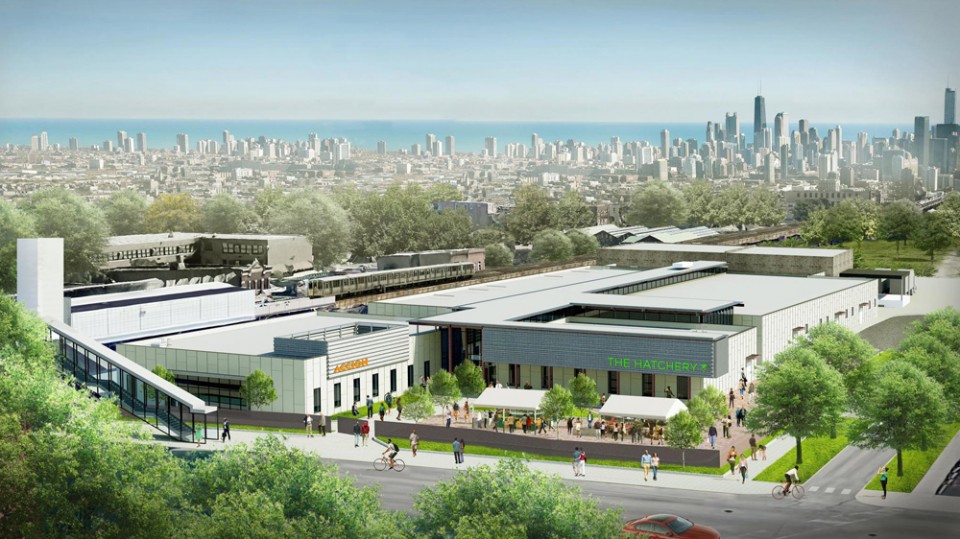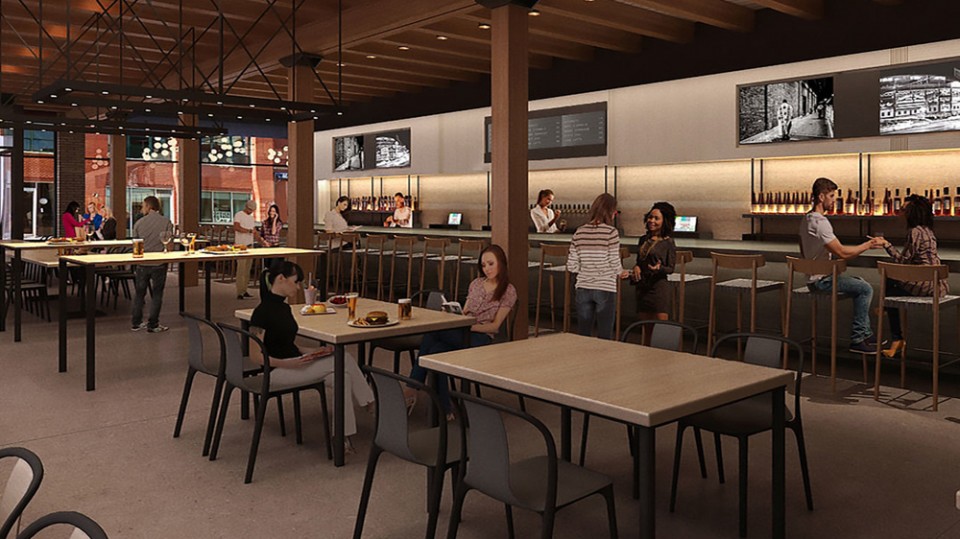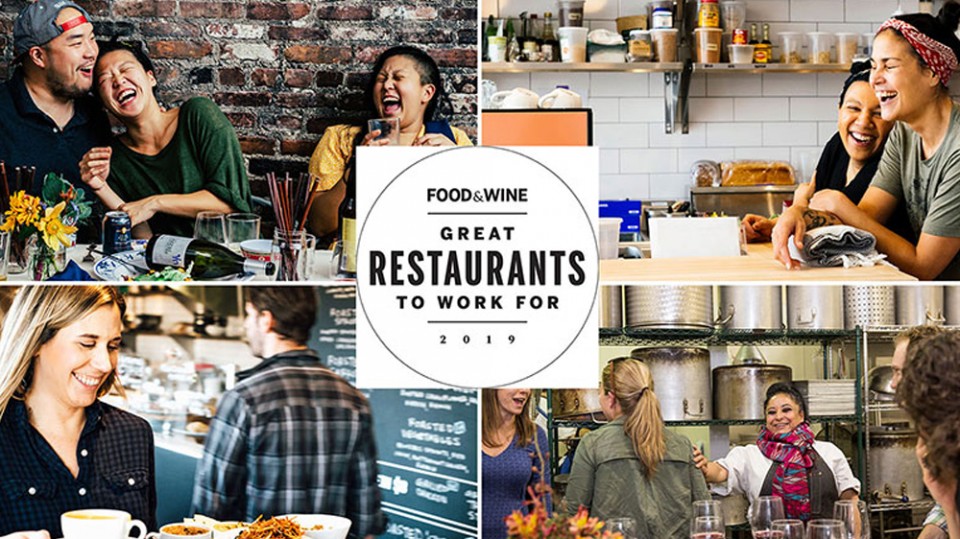
Apr 20, 2019
Food Dive | Megan Poinski | April 17, 2019
The new 67,000-square-foot facility is open for business with ingenuity from entrepreneurs and several partnerships with big food companies including PepsiCo, Conagra Brands and Kellogg.
CHICAGO — From outside of Chicago, it feels like The Hatchery is a long-established institution.
Since it was started as part of local incubator Industrial Council of Nearwest Chicago in 2015, The Hatchery has been collecting high-profile partnerships from companies including Kellogg, Conagra, PepsiCo, Ingredion and most recently Mondelez. For years, the incubator has been working with companies, facilitating networking and helping connect entrepreneurs to people and resources they need.
But traveling to the food incubator’s home in Chicago’s East Garfield Park neighborhood, it feels brand new — and bursting with possibilities. The 67,000-square-foot building went up so recently, Google Maps still shows a photo of a construction site at the address.
In mid-April, construction vehicles and maintenance workers tended to the front courtyard where a neighborhood food market will soon be set up. The inside of the building smelled like fresh paint. The shared kitchen spaces were mainly empty, and the Rick Bayless restaurant kitchen lab still lacked equipment. Chairs and tables for a shared office space were jumbled together, ready to be organized.
CEO Natalie Shmulik said The Hatchery’s building just opened in January, and it’s only been producing food since February. And while there was a ribbon cutting at the facility four months ago, its grand opening celebration is actually scheduled for this week.
At The Hatchery’s new facility, Shmulik told Food Dive that the incubator operated virtually for its first years, with offices in ICNC’s massive complex. However, the need for the new $30 million building — designed specifically for food businesses and their needs — was quickly apparent.
“Initially, the intention was: we’ll build this facility, we open the facility and then we launch. But that would have been a big mistake,” Shmulik said. “Just like the advice we give to our entrepreneurs, it would have been a big disservice for us and for the companies we work with if we hadn’t tested the concept before officially launching.”
This helped shape The Hatchery as an institution and as a facility. While entrepreneurs clearly needed food-grade kitchen space, Shmulik found they also needed space for storage, as well as space to do administrative work. Many startups, she said, would rent out additional space in co-working office facilities for the administrative part of their businesses. And, of course, entrepreneurs working with an incubator program benefit from space to learn from peers in the business and through networking.
The Hatchery’s facility has 55 food-grade private production spaces and a large shared kitchen. There is a large warehouse in the back, which has cold storage, dry storage, loading docks and places to load up food trucks. There are several meeting rooms of various sizes, easily booked for meetings with funders or for team discussions.
There is a large area for lectures and classes, with a display kitchen on one side — eventually which may be used for pop-up lunches by catering companies working in The Hatchery, as well as professional food photography. One large kitchen area will be a classroom for chef Rick Bayless’s restaurant training center, which will educate underserved youth in culinary skills so they can work in restaurants — supporting both the community as well as Chicago’s thriving restaurant scene.
The Hatchery also shares office space with Accion, a nonprofit microlender that provides small business loans of up to $100,000. Shmulk said they have focused on minority and women-owned businesses, and have done a lot of work with food companies working with ICNC’s incubator program. She said it’s a natural partnership to have the financer right on site.
Shmulk said more than four years were spent just planning The Hatchery’s building. The construction is modular so it can easily change and adapt to future needs.
“We’re always still learning, but we really had to engage a lot of industry experts and learn from others to try to make sure that we outfit everything the right way, and there will still likely be changes as the industry changes,” she said.
CLICK HERE TO READ THE FULL ARTICLE

Apr 13, 2019
Chicago Magazine | Carly Boers, John Kessler, Jeff Ruby, Carrie Schedler, and Claire Voon | April 13, 2019
It’s the Year of the Indie: These 15 spots, all but one of which are independently owned, show off Chicago’s culinary scene at its charming, idiosyncratic best.
Kyoten | 2507 W. Armitage Ave. | Logan Square | Sushi

Pacific Standard Time | 141 W. Erie St. | River North | Contemporary American

Passerotto | 5420 N. Clark St. | Andersonville | Korean-Italian

Xocome Antojeria | 5200 S. Archer Ave. | Archer Heights | Mexican

Etta | 1840 W. North Ave. | Bucktown | Contemporary American

Landbirds | 2532 N. California Ave. | Logan Square | Korean

All Together Now | 2119 W. Chicago Ave. | West Town | Contemporary

Bar Biscay | 1450 W. Chicago Ave. | Noble Square | Spanish

The Swill Inn | 415 N. Milwaukee Ave. | West Town | American

Bayan Ko | 1810 W. Montrose Ave. | Ravenswood | Filipino-Cuban

Yokocho | Location to be Determined

Funkenhausen | 1709 W. Chicago Ave. | West Town | German

Aba | 302 N. Green St. | West Loop | Mediterranean

Luella’s Gospel Bird | 2009 N. Damen Ave. | Bucktown | Southern

Munno Pizzeria & Bistro | 4656 N. Clark St. | Ravenswood | Italian

CLICK HERE TO READ THE FULL ARTICLE AND DETAILS ON THE RESTAURANTS ABOVE

Apr 6, 2019
Food & Wine | Nina Friend | April 2, 2019
Galley Group’s first Windy City venture – Fulton Galley – will open in June, showcasing local chefs.
Galley Group, a restaurant group that develops and manages food halls, claims that their projects aren’t just food halls; they’re small business incubators. The food hall backdrop provides local chefs with an opportunity to launch restaurant concepts in an environment that’s less costly and less risky than opening a place of their own—with the ultimate goal of using the experience as a launch pad for their careers.
The restaurant group operates four locations across the country: Smallman Galley and Federal Galley in Pittsburgh, Ohio City Galley in Cleveland, and Fort Street Galley in Detroit. Their fifth is opening in Chicago this June. Fulton Galley—which will be located in the Fulton Market area of Chicago’s West Loop neighborhood—will feature five concepts from local chefs. The opening lineup will include a casual taqueria, a modern Thai restaurant, a Jewish deli, an Italian concept, and a rotisserie-focused spot.
The first class to work out of Fulton Galley encompasses chefs of all kinds of backgrounds. Ron Aleman, a Mexican-American chef with classical French training, will operate Taco Mucho. Having worked in Chicago restaurants for over two decades, Aleman told Food & Wine that this opportunity is his way of coming full circle and returning to his family’s kitchen table. Palita Sriratana, who staged at Chicago staples Au Cheval and Nico Osteria, will focus on Isaan food, a cuisine of Northeastern Thailand. Her family-style concept, called Pink Salt, is inspired by childhood summers at her mother’s home in Nonthaburi, Thailand.
Aaron Steingold’s eponymous Jewish deli similarly draws from early memories eating at delis in New York City. He plans to modernize the concept by offering dinner items like a Jewish take on ramen. The Italian spot, Italianette, will be run by a husband-wife team, Gerad Gobel and Alexis Rorabaugh. Both Gobel and Rorabaugh currently work as executive chefs at Soho House Chicago. The rotisserie restaurant, Fairview, will draw from the flavors of chef Dennis Bernard’s upbringing in Central America. Bernard’s experience includes being chef de cuisine at The Publican as well as time spent at Blackbird, Dove’s Luncheonette, and Big Star.
Like with the other Galley Group concepts, the idea with the Chicago space is that new chefs will consistently rotate in, bringing new talent as well as new cuisines. Every chef receives a fully built-out kitchen and front-of-house staff, among other perks, so that they can focus on building their concepts.
CLICK HERE TO READ THE FULL ARTICLE

Mar 30, 2019
MLB | March 30, 2019
While everyone looks forward to the traditional hot dog, popcorn, peanuts, and beer to snack on while watching their favorite baseball team knock it out of the park, there is so much more for your taste buds to enjoy at stadiums these days. Whether you cheer on the North Side Cubs or the South Side White Sox, Chicago’s baseball stadiums have great food offerings in and around them that will be sure to keep you fueled up well past the seventh-inning stretch.
Let Chicago’s Crosstown Classic of Taste begin…
WRIGLEY FIELD
Home of the Chicago Cubs and more than a century of baseball history (since 1916). This iconic stadium has been undergoing renovations to its infrastructure as well as its food menus. Click below to check out all of the tasty surprises that Wrigley Field has in store for fans this season.
WRIGLEY FIELD – 2019 FOOD & BEVRAGE LINEUP
GUARANTEED RATE FIELD
The Chicago White Sox have called this stadium home since 1991 after being in their original stadium, Comiskey Park, in the same location for 81 years. This Dan Ryan Expressway adjacent site has always been a billboard for the Sox for over a century. Click below to see all of Guaranteed Rate Field’s delicious offerings.
GUARANTEED RATE FIELD – 2019 FOOD & BEVRAGE LINEUP

Mar 23, 2019
Food & Wine | Tracie McMillan | March 18, 2019
Meet the chefs and restaurateurs who are making restaurant jobs better.
When it comes to working in the average restaurant in America today, there is good news, and there is bad news.
The bad news probably won’t surprise you. As an industry, food preparation and serving post the lowest wages in the countrythis link opens in a new tab, with half of workers earning well under the median living wage. Sexual harassment, brought to center stage with the #MeToo movement, has been more commonly reported by workers in restaurants than any other industry over the past two decadesthis link opens in a new tab. When Just Capital, a survey group dedicated to corporate accountability, ranked 890 publicly traded companiesthis link opens in a new tab in 33 industries based on worker treatment, “restaurants and leisure” as a category ranked second to last.
In America’s more than 640,000 restaurantsthis link opens in a new tab, most workers, whether in award-winning fine-dining kitchens or massive corporate chains, know that it is bad. In 2017, the turnover rate in accommodation and food services was 72.5 percent, compared to a total private employment turnover rate of 47.4 percent—putting restaurant turnover rate at 53 percent higher than the national average. When worker advocacy group Restaurant Opportunities Center United surveys restaurant workers, they find that “the biggest issues [workers] confront is wages first, benefits like paid sick leave, and mobility—especially on the basis of race, but also gender,” says Saru Jayaraman, the group’s cofounder and president.
Much of this has been par for the course for decades, with an origin story in the brigade system that defined renowned European kitchens. When Anthony Bourdain wrote a tributethis link opens in a new tab to Marco Pierre White’s 1990 genre-defining White Heat for the book’s 25th anniversary, he called the industry’s work conditions “a cycle of abuse that passed as learning one’s trade.” It makes a certain kind of sense that cooks made their work’s lawlessness and cruelty into a badge of honor. And yet, some operators are beginning to suspect that the rock-and-roll kitchen tales may have been something else: a myth that helped make the unbearable, bearable.
And this brings us to the good news.
Today, an increasing number of restaurateurs have set out to improve restaurant jobs. Some have done this for decades; others are new to the effort. Either way, they are boosting wages and expanding benefits. This is happening in the liberal enclaves of Brooklyn and Seattle, but it’s also bubbling up in conservative bastions, like Boulder, Utah, population 200, and Indianapolis, too. (And it is happening even as the federal government has ignored calls to raise wages for the past decade.)
Some of the improvements are happening for practical reasons. America’s tight labor market is tighter still in restaurants, the country’s third-largest industry, and kitchens have been particularly hard-hit by immigration restrictions. Restaurants now work harder to attract and keep good workers. They cast wider nets in hiring, and some restaurateurs now seek out returning citizens (people coming home from prison), for both kitchen work and the well-paid front of the house. And they seek to reduce turnover, a goal that many who’ve dropped the traditional tip model—by pooling tips across workers or by replacing tips with a living wage—say they’ve achieved.
But there is passion, too, some of it long-standing. “You are not allowed to pick up a baguette and pretend it’s a dick in my restaurant,” says Martha Hoover, who helms Indianapolis’ 13-outlet Patachou Inc., now in its thirtieth year, which runs employees through implicit bias training and has a zero-tolerance policy on harassment and discrimination. And for chefs who came up in rough-and-tumble kitchens, there can be a drive to make it better for the next generation. “I’ve worked in places you dreaded to be,” says F&W Best New Chef 2016 Edouardo Jordan, of Seattle’s JuneBaby, Salare, and Lucinda Grain Bar restaurants, who starts workers well above the state’s $12 minimum wage; he also pays 50 percent of health insurance premiums and covers paid vacation for anyone working 30 hours a week. “I was never able to have insurance as a young cook; I think only one time I had vacation pay,” he says. “And I don’t want to put anyone through that life.”
In the profiles that follow, you’ll learn about 19 American restaurants that are creating better workplaces for staff. So what does a great restaurant to work for look like? It may have an open kitchen, which operators say promotes better professional conduct, and open books, which helps workers learn the business. It may have set schedules and pooled tips, which take guesswork out of the job and promote stability. And there is almost assuredly a dedication to treating restaurant workers as something they have rarely been given credit for: professionals.
- AC Restaurants | Ashley Christensen | Raleigh, NC | 200 employees
- Ardent | Justin Carlisle | Milwaukee, WI | 9 employees
- Barrio Café and Barrio Café Gran Reserva | Silvana Salcido Esparza | Phoenix, AZ | 32 employees
- Bini’s Kitchen | Binita Pradhan | San Francisco, CA | 14 employees
- Biscuit Love | Karl and Sarah Worley | Nashville, TN | 130 employees
- Cala | Gabriela Cámara | San Francisco, CA | 45 employees
- Dinette | Sonja Finn | Pittsburgh, PA | 12 employees
- Egg | George Weld and Evan Hanczor | Brooklyn, NY | 26 employees
- Folk and The Farmer’s Hand | Rohani Foulkes and Kiki Louya | Detroit, MI | 19 employees
- Giant | Jason Vincent | Chicago, IL | 25 employees
- Hell’s Backbone Grill and Farm | Jen Castle and Blake Spalding | Boulder, UT | 50 employees
- JuneBaby, Salare, and Lucinda Grain Bar | Edouardo Jordan | Seattle, WA | 52 employees
- Mama J’s | Velma and Lester Johnson | Richmond, VA | 60 employees
- Mei Mei | Irene, Margaret, and Andrew Li | Boston, MA | 25 employees
- Mondo and Rosedale | Susan Spicer | New Orleans, LA | 57 employees
- Patachou Inc. | Martha Hoover | Indianapolis, IN | 350 employees
- Thai Fresh | Jam Sanitchat and Bruce Barnes | Austin, TX | 48 employees
- Vimala’s Curryblossom Cafe | Vimala Rajendran | Chapel Hill, NC | 27 employees
- Zingerman’s Community of Businesses | Ari Weinzweig | Ann Arbor, MI | 700 employees
CLICK HERE TO READ THE FULL ARTICLE AND DETAILS ON THE RESTAURANTS ABOVE




















